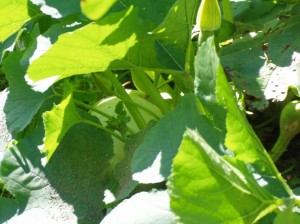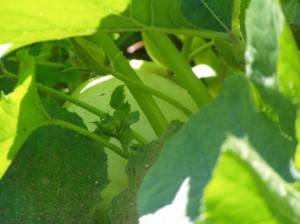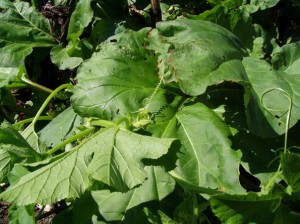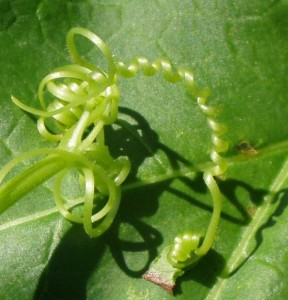 Shhhhhhhh. We’ve now encountered the elusive spaghetti squash in her native habitat. If you look carefully, you can see her crouching here, under the large spiny leaves toward the back.
Shhhhhhhh. We’ve now encountered the elusive spaghetti squash in her native habitat. If you look carefully, you can see her crouching here, under the large spiny leaves toward the back.
Quiet now; we don’t want to spook her.
 As you can see, she is taking what is referred to as ‘the spaghetti squash protective squat’, the position where she feels at her safest. She will not move from this position unless attacked.
As you can see, she is taking what is referred to as ‘the spaghetti squash protective squat’, the position where she feels at her safest. She will not move from this position unless attacked.
You’ll notice that she’s attached herself to almost every plant around her. This is another protective strategy. If we pull, it is apt to bring the whole support structure down around us, so we must be very very careful. Spaghetti squashes use a devious and intricate system of vines and offshoots to gain and secure their territory. Let’s see if we can zoom in and take a look.
 As you can see, she has thrown out quite a flamboyant series of tendrils here to attach herself to the rhubarb plants, in an effort to throw us off finding her. The large leaves of the rhubarb are slowly but surely being pulled toward the vines.
As you can see, she has thrown out quite a flamboyant series of tendrils here to attach herself to the rhubarb plants, in an effort to throw us off finding her. The large leaves of the rhubarb are slowly but surely being pulled toward the vines.
You have to give these great predators a lot of credit. Let’s look more closely at that tendril..
 As you can see, the tension at the spring end has literally torn a chunk out of the leaf. The rhubarb plant is no match for the squash at all. She won that contest in a walk.
As you can see, the tension at the spring end has literally torn a chunk out of the leaf. The rhubarb plant is no match for the squash at all. She won that contest in a walk.
OK – enough of the breathless “Wild Kingdom” tours. Why grow spaghetti squash? Why eat it?
Especially when you consider (and you can’t see it here), once they get going, it’s very difficult to keep them in check. They crawl all over the place. The only way we have found here to keep them under some sort of control, frankly, is the rather crude use of the lawn mower once the vines reach the driveway. It’s either that… or we’d never find the car in the morning. The vines will have swallowed it up. (cue scary music from “Jaws”)
But spaghetti squash is more than just a substitute for pasta in a low calorie or controlled glycemic load diet. As a winter squash, it is actually a very good source of vitamins and minerals and the yellow and orange types have high levels of beta carotene in them. Also from a nutritional standpoint, they are powerhouses of B6, niacin, manganese, fiber and Vitamin C.
Just as a point of comparison, let’s look at 1 cup of spaghetti squash versus 1 cup of, well, spaghetti (both prepared in their usual fashion with no salt added.
Spaghetti Squash………………….Spaghetti
Calories…42……………………..221
Carbs……10 gr…………………..43 gr
Glycemic Load 2…………………..23
Omega 3/Omega 6 Ratio
……….121 mg/72.8 mg…………..33.6 mg/413 mg
Protein…3 gr……………………8 gr
So, let’s look at these numbers. Ok, so the vegetable beats out the pasta on the calorie count. To be expected, as is the amount of carbohydrate. The glycemic load tells us that the squash hardly raises blood sugar at all; whereas the spaghetti is in the ‘Holy Ned” range (not good for inflammation). In terms of fats, the squash has an almost 2:1 ration of good to bad fats; the spaghetti has over ten times the bad fats in comparison to the good fats. The only place where the pasta ‘wins’ is in the protein area, with 8 grams versus 3 for the squash. But let’s look at what those 8 grams are costing you – to get those 8 grams ‘costs’ 221 calories, or 38 calories for each gram of protein (and for anyone counting, the protein in the pasta is gluten from the flour and a lot of people have health issues with gluten).
The spaghetti squash only has 3 grams of protein, but those 3 grams only ‘cost’ 42 calories, or 14 calories per gram of protein – definitely more ‘bang for the buck’.
Now, though eating a plateful of spaghetti squash all by itself (or even with other veggies) will fill you up tremendously, you’ll want a bit more protein on the plate. If you go on the internet and search for recipes, a lot of them use cheese, or meat as their protein source; however, you can also find recipes using nuts or seeds or beans as the proteins and these will get you even more fiber and protein and will save you issues on the fat side if that is what you are looking for.
Cooking spaghetti squash is simplicity itself, really. First, cut it open (which will take a bit of muscle since this IS a winter squash so the rind is hard (though much easier to cut up than Hubbard, for example) and scoop out the seeds.
For baking, spray the bottom of a baking pan with olive oil or put a bit of grease on it. Then lay the cut halves of the squash cut side down on the pan and bake for 30-40 minutes at 375 degrees F.
To microwave, again, cut the squash in half and clean out the seeds, then put face down in a glass baking dish and ‘nuke’ for 6-8 minutes and then let stand for a few minutes afterwards.
In either method, when it’s done cooking, then flip the halves over, run a fork from one end to the other to loosen up the strands, put them in a bowl and then serve (with or without sauce). Could not be easier, or more nutritious.